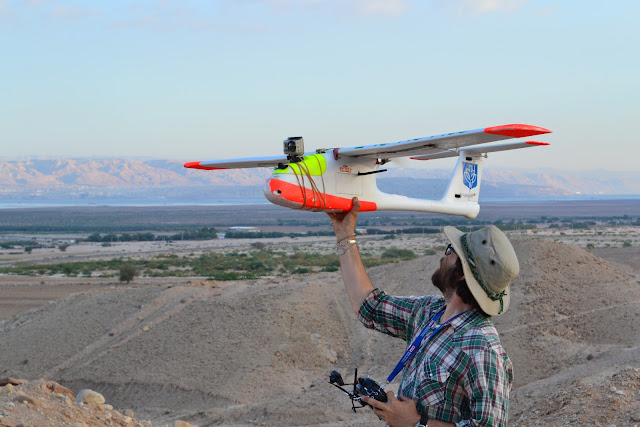Austin “Chad”
Hill, a research scientist at the University of Connecticut, prepares a fixed
wing drone for a
flight over the landscape at Fifa in Jordan. Hill works with archaeologist
Morag M. Kersel,
an assistant professor at DePaul University, using drones for site
documentation
and monitoring at
the site with the support of the Jordanian Department of Antiquities.
(Photo by Morag M.
Kersel, courtesy of the Follow the Pots Project)
(February 14, 2016) “Drones
are proving to be powerful new tools to archaeologists for documenting
excavation, mapping landscapes and identifying buried features. They also can
be applied to monitor site destruction and looting in the present,” said Morag
M. Kersel, an assistant professor of anthropology at DePaul.
Kersel, whose research focus is on trade and antiquities,
described how drones are an emerging tool for archeology during a presentation
Feb. 14 at the annual meeting of the American Association for the Advancement
of Science. Kersel’s presentation, "UAVs for Site Documentation and
Monitoring," was part of a session that examined the protection of
cultural heritage sites and artifacts.
“Three seasons of monitoring at Fifa have demonstrated that
UAVs can provide quantifiable evidence for the rate of ongoing site damage,
even in contexts where other remote sensing systems would provide insufficient
data,” said Kersel.
“Between 2013-14, we had 34 new looting episodes — holes —
clearly people were still looting. In the next year, there’s very little or no
evidence of looting. Why?” Kersel said. “Is it because there is no demand Early
Bronze Age ceramics?
“An element of the ongoing research is the examination of
why looting has abated? Are there no more graves to loot? Have looters found
more lucrative financial resources? Are the Department of Antiquities and NGO
initiatives working?” she asked.

